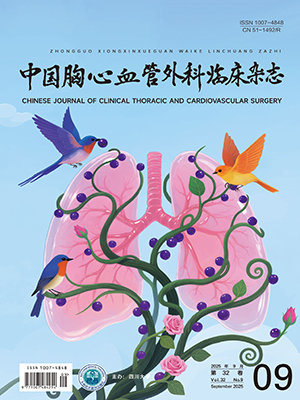| 1. |
Conrad SA, Rycus PT, Dalton H. Extracorporeal life support registry report 2004. ASAIO J, 2005, 51(1): 4-10.
|
| 2. |
格日乐, 李志涛.体外膜肺氧合的护理.中外健康文摘, 2012, 9(22): 351-352.
|
| 3. |
黑飞龙, 龙村, 于坤, 等.体外膜肺氧合并发症研究.中国体外循环杂志, 2005, 3(4): 243-245.
|
| 4. |
Cilley RE, Zwischenberger JB, Andrews AF, et al. Intracranial haemorrhage during extracorporeal membrane oxygenation in neonates. Pediatrics, 1986, 78(4): 699-704.
|
| 5. |
Cengiz P, Seidel K, Rycus PT, et al. Central nervous system compli-cations during pediatric extracorporeal life support: incidence and risk factors. Crit Care Med, 2005, 33(12): 2817-2824.
|
| 6. |
Rollins MD, Yoder BA, Moore KR, et al. Utility of neuroradiogra-phic imaging in predicting outcomes after neonatal extracorporeal membrane oxygenation. J Pediatr Surg, 2012, 47(1): 76-80.
|
| 7. |
Lidegran MK, Mosskin M, Ringertz HG, et al. Cranial CT for diagnosis of intracranial complications in adult and pediatric patients during ECMO: Clinical benefits in diagnosis and treatment. Acad Radiol, 2007, 14(1): 62-71.
|
| 8. |
Bembea MM, Felling R, Anton B, et al. Neuromonitoring during extracorporeal membrane oxygenation: a systematic review of the literature. Pediatr Crit Care Med, 2015[Epub ahead of print].
|
| 9. |
Zhang J, Zhang CH, Lin XL, et al. Serum glial fibrillary acidic protein as a biomarker for differentiating intracerebral hemorrhage and ischemic stroke in patients with symptoms of acute stroke: a systematic review and meta-analysis. Neurol Sci, 2013, 34(11): 1887-1892.
|
| 10. |
Mercier E, Boutin A, Lauzier F, et al. Predictive value of S-100βprotein for prognosis in patients with moderate and severe traumatic brain injury: systematic review and meta-analysis. BMJ, 2013, 346: f1757.
|
| 11. |
Stang A. Critical evaluation of the Newcastle-Ottawa scale for the assessment of the quality of non-randomized studies in meta-analyses. Eur J Epid, 2010, 25(9): 603-605.
|
| 12. |
Gazzolo D, Masetti P, Meli M, et al. Elevated S100B protein as an early indicator of intracranial haemorrhage in infants subjected to extracorporeal membrane oxygenation. Acta Paediatr, 2002, 91(2): 218-221.
|
| 13. |
Nguyen DN, Huyghens L, Wellens F, et al. Serum S100B Protein Could Help to Detect Cerebral Complications Associated with Extracorporeal Membrane Oxygenation (ECMO). Neurocrit Care, 2014, 20(3): 367-374.
|
| 14. |
Floerchinger B, Philipp A, Foltan M, et al. Neuron-specific enolase serum levels predict severe neuronal injury after extracorporeal life support in resuscitation. Eur J Cardiothorac Surg, 2014, 45(3): 496-501.
|
| 15. |
Bembea MM, Savage W, Strouse JJ, et al. Glial fibrillary acidic protein as a brain injury biomarker in children undergoing extracorporeal membrane oxygenation. Pediatr Crit Care Med, 2011, 12(5): 572-579.
|
| 16. |
吴蓓, 龙村.体外膜肺氧合与脑损伤.中国体外循环杂志, 2009, 7(4): 246-249.
|
| 17. |
龙村, 胡盛寿, 刘晋萍, 等.体外膜肺氧合支持治疗在成人终末期心脏病中的临床应用.中国胸心血管外科临床杂志, 2007, 14(5): 334-337.
|
| 18. |
Hervey-Jumper SL, Annich GM, Yancon AR, et al. Neurological complications of extracorporeal membrane oxygenation in children. J Neurosurg Pediatr, 2011, 7: 338-7344.
|
| 19. |
Mateen FJ, Muralidharam R, Shinohara RT, et al. Neurological injury in adults treated with extracorporeal membrane oxygenation. Arch Neurol, 2011, 68: 1543-1549.
|
| 20. |
刘学敏.不同孕龄胎盘和脐带组织中S100b、NSE、GFAP的表达.中国医科大学硕士学位论文, 2007.
|
| 21. |
Nagdyman N, Kö men W, Ko HK, et al. Early biochemical indicators of hypoxic-ischemic encephalopathy after birth asphyxia. Pediatr Res, 2001, 49(4): 502-506.
|
| 22. |
Gazzolo D, Marinoni E, Di Iorio R, et al. Measurement of urinary S100B protein concentrations for the early identification of brain damage in asphyxiated full-term infants. Arch Pediatr Adolesc Med, 2003, 157(12): 1163-1168.
|




